A Wining Cost Estimate
That Helps You To Win More Flooring Projects
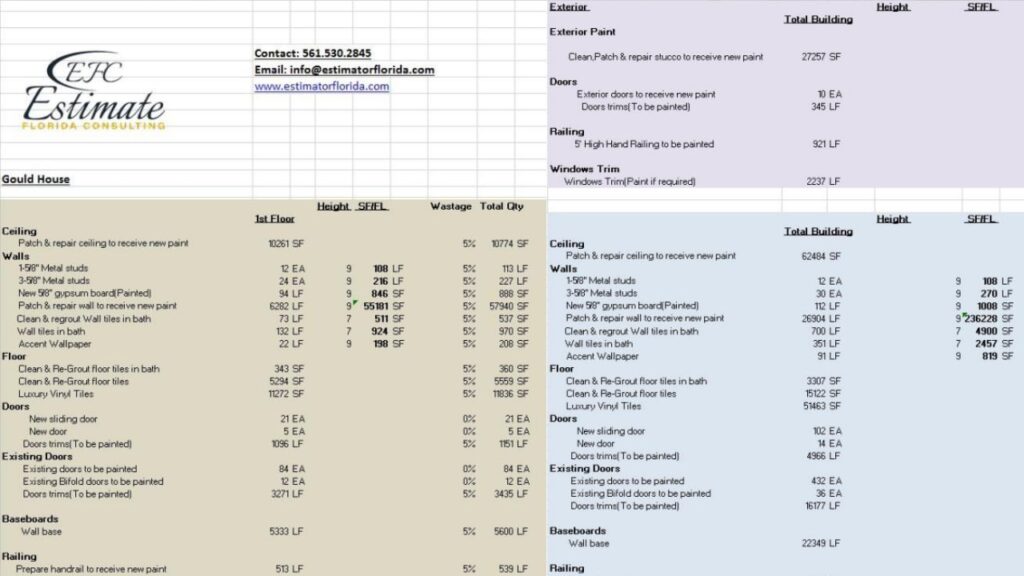
To understand flooring estimator with what it is and its importance, here are the sub-sections you need to explore. First, discover what a flooring estimator is and its primary purpose. Then, in order to make informed decisions while considering renovations or new construction projects, learn the significance of this measurement tool in estimating flooring costs.
The role of a Flooring Estimator involves assessing the costs and requirements for installing various types of flooring in a given space. They take into account variables such as material, labor costs, and timeframes to provide an accurate estimate for clients. A well-rounded estimator can also provide advice on different types of flooring that might suit a particular space.
Additionally, a Flooring Estimator must possess good communication skills to ensure that clients understand what their quote entails and prevent confusion down the line. They must also be organized and analytical since they often have several projects running simultaneously.
Interestingly enough, the demand for Flooring Estimators has been on the rise in recent years due to increased construction activity across many different sectors. In other words, this is an excellent career path for people interested in construction and finance alike.
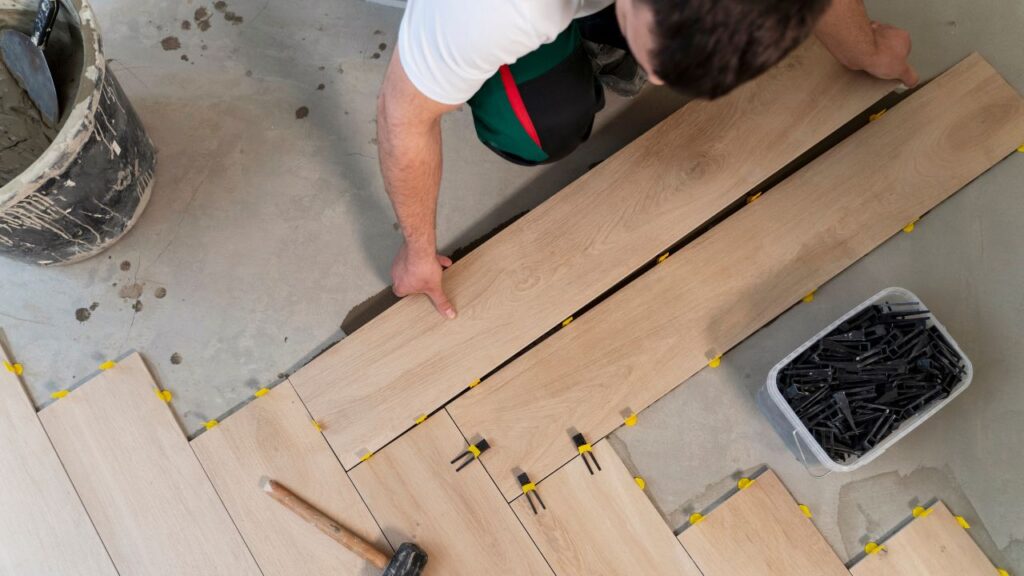
In fact, we heard of a story where a Flooring Estimator worked with an architect on some flooring installations for an off-shore drilling platform. The work involved coordinating with suppliers in different countries and adhering to strict safety standards while working atop steel constructions 200ft above the ocean. At its conclusion, he remarked that it was one of the most challenging yet rewarding projects he had ever worked on.
Without a flooring estimator, your wallet will feel as empty as the room with bare floors.
Flooring estimator plays a vital role in determining the cost of flooring for your space. It is essential to understand the importance of accurate measurements and calculations to avoid any confusion during the project. With the flooring estimator, you can get an approximate cost estimate based on various factors, including square footage, material type and installation fees.
Accurate estimation helps in planning a budget, selecting appropriate materials and avoiding unnecessary expenses. The flooring estimator allows you to explore different options by comparing costs and choosing what fits best with your budget and requirements. In addition, it helps in negotiating prices with contractors based on the estimated cost.
Moreover, the quality of workmanship can be ensured by opting for competent installers within the budget constraints. By having realistic estimates, it reduces ambiguity and increases transparency between clients and contractors, making both parties satisfied.
A study showed that 85% of remodeling projects exceed their initial budgets mainly due to inaccurate cost estimations. Therefore, utilizing reliable tools like flooring estimator can save time and money for future endeavors.
In summary, understanding flooring estimator’s importance is crucial in successfully completing home or office renovation projects within budgets whilst ensuring quality workmanship without compromising on standard materials selection better than industry average.
Before you dive into the factors affecting floor estimating, just remember – your floor won’t estimate itself, but our article is here to help.

To accurately estimate the cost of a flooring project with an eye on your budget, you must consider several factors. Consider types of flooring materials, the size, and shape of the room, the necessary preparation of the subfloor, and the level of labor required. In this section, we’ll explore these factors in detail to help you create a comprehensive flooring estimate that meets your requirements.
There are various kinds of flooring materials available in the market, each with its unique features and characteristics that make it suitable for specific purposes. Let’s explore some of these options.
Flooring Material | Characteristics |
|---|---|
Hardwood | Durable and long-lasting, easy to refinish |
Laminate | Affordable and versatile, resistant to scratches |
Carpet | Comfortable and warm, available in different textures |
Ceramic Tiles | Water-resistant and easy to clean, ideal for wet areas |
Vinyl | Low-maintenance and affordable, comes in different patterns |
It’s worth noting that some materials like hardwood require more time to install due to their complex designs. Similarly, the cost of installing certain types of materials can vary based on local labor rates.
When deciding on which flooring material to use, do not forget to consider factors like the amount of foot traffic that would be passing through the area. If you’re unsure about which option is best for your space, consult with a professional who can provide guidance based on your specific needs.
Don’t miss out on the benefits that come with selecting the right flooring material. Choose wisely!
Remember, the bigger the room, the higher the estimate – unless you’re a magician and can make flooring appear out of thin air.
When considering flooring estimating, the scale and configuration of the space can significantly impact cost. Here are some considerations for Size and Shape of the Room that may affect flooring costs:
Size of the room | Small spaces can have lower material and labor costs than larger rooms. |
Shape of the room | Rooms with many corners or curves require greater trimming and cutting compared to rectangular ones. |
Ceiling Height | A higher ceiling can influence quantities for materials related to baseboards or trims |
Moreover, flooring within a large open concept living area may contain different segments that correspond to zones such as kitchens, eating areas, and living rooms. Segmenting could result in increased cost because different forms of materials are usually needed.
One example is carried out by Tim who measured his living room which had equaled roughly to forty square meters but had abnormal sides adjusted within various angles. He discovered he required two squares per tile; nevertheless, Tim found a concern as each tile was just one meter in width, meaning an entire line was essential therefore extra tiles required ordering. As a result of examining precisely how much more he required renewed his request with added tiles which ultimately incurred more expense to his initial expected plan.
Therefore, evaluating size and shape concerns while providing accurate sums for potential flooring costs is crucial when avoiding additional upfront pricing uncertainties when creating your budget plans related to new floors installments.
The only thing worse than a bad subfloor is pretending it’s not a problem and hoping it’ll magically fix itself.
To ensure a smooth and long-lasting flooring installation project, subfloor preparation is crucial. Without proper preparation, problems like squeaky floors, uneven surfaces or premature wear and tear can happen. Here’s a guide to help with your subfloor preparation:
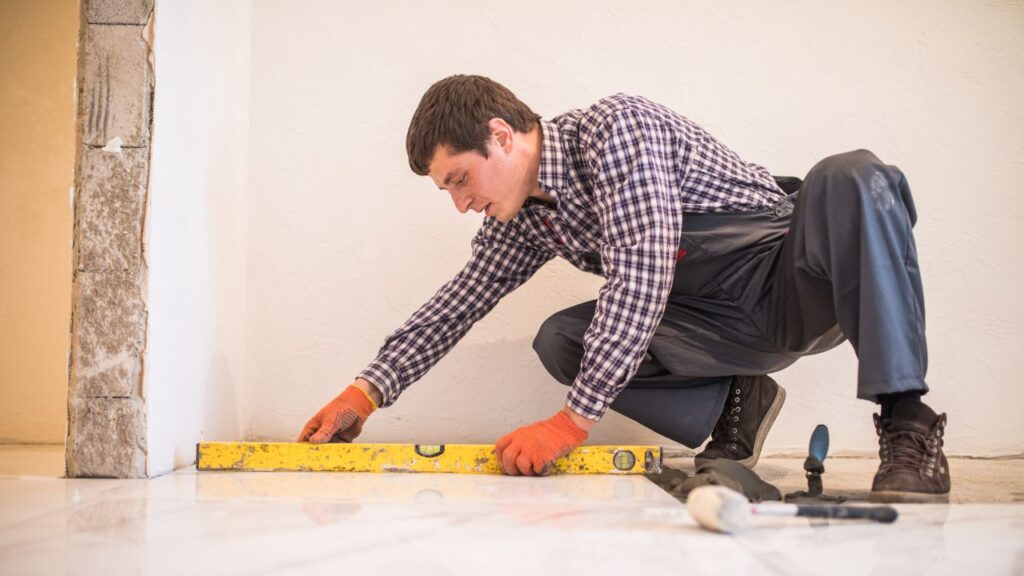
It’s also essential to note that subfloors vary depending on their location – above-grade or below-grade – so it’s important to adapt your steps accordingly.
Pro Tip: Always follow the manufacturer’s instructions when using adhesives, underlayment and other materials during the subfloor preparation stage to avoid potential damage or voided warranties.
Counting your labor costs for flooring? Just remember, you get what you pay for – unless you’re a magician, don’t expect a cheap team to pull off a flawless finish.
Labor Skill and its Impact on Flooring Estimating
As we delve deeper into the factors that affect flooring estimation, one key aspect is the level of labor involved. The skill level and expertise of the labor force directly impact the amount of time and effort required to carry out a project, which in turn affects the cost.
A Breakdown of Labor Costs
To understand how labor impacts flooring estimating, let’s break down the costs associated with various levels of labor:
Skill Level | Hourly Rate | Average Project Completion Time |
|---|---|---|
Novice | $10 – $20 | 2x-3x longer |
Intermediate | $20 – $40 | No difference or 1.5x longer |
Expert | $40 – $80 | Up to 50% shorter |
The more skilled the labor force is, the less time they require to complete a project. This impacts overall cost since less time equals fewer expenses for materials, transportation and equipment rental.
It is important to note that some projects may require specific skills that are not easy to come by or may be regarded as rare. This can greatly increase project completion times.
Further Insights into Labor in Flooring Estimation
Moreover, it is essential for companies to enter into binding contracts with their contractors’ labors before any work begins. It ensures that no hidden costs emerge due to time overruns or inaccurate understanding of what is required from each side.
It’s also important for contractors to source their workforce carefully so that only skilled professionals are employed. It contributes significantly to preventing any delays when carrying out a project.
A Historical Case In Point
In 1987, an outsourcing company estimated that they would complete a software development task in three weeks at an hourly rate of six dollars per hour if they hired unskilled workers instead of experienced ones who charged twice as much.
They soon found out hiring inexperienced people enabled them increased productivity… but also revealed glaring inefficiencies in the firm’s workflow. They ended up taking twice as long to complete the task, which delayed distribution and increased overall cost. This proves how skilled labor is important, even if it comes at a higher rate.
From the meticulous measurer to the wild guesser, the types of flooring estimators are as diverse as the flooring options themselves.

To help you accurately estimate flooring costs and requirements, you need to understand the different types of flooring estimators available. In order to ease this process, this section dives into the two main types of flooring estimators, which are the online flooring estimator and the manual flooring estimator.
For the technologically-driven individual, there are various digital tools available to ease and simplify the process of flooring estimation. These software resources utilize dynamic algorithms that generate a visual representation of the measurements for your desired project.
A table highlighting the features of Online Flooring Estimators is as follows:
Features | Details |
|---|---|
Platform compatibility | Works on multiple platforms including desktop and mobile devices |
Digital Measurement Tool | Accurately computes necessary floor dimensions via image processing |
Real-time Cost Estimates | Provides instant estimates based on chosen materials and room size |
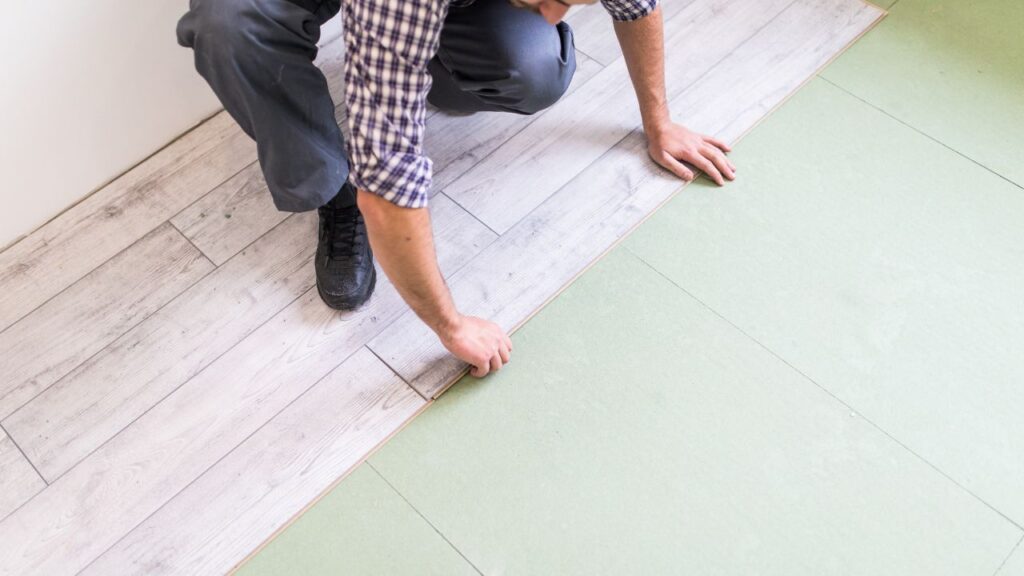
It is worth noting that even though there are several free online estimators, some may require additional expenditure to gain complete access to their utilities. It is vital to do prior research while selecting an online flooring estimator.
Pro Tip: When using an online estimator tool, ensure that you have precise measurements and double-check all input data for maximum accuracy in cost estimation.
Choosing the right flooring estimator is like finding a needle in a haystack, but the advantages it brings to your wallet and sanity are worth the effort.
Flooring Estimators: Benefits and Types
Flooring estimators are essential in the flooring industry as they provide accurate measurements and cost estimates for different types of flooring projects. There are numerous advantages to using these tools, which ultimately help assist in making informed decisions when planning a flooring project.
Additionally, there are various types of flooring estimators available such as mobile apps, web applications, and software programs. These platforms offer varying features based on user needs and familiarity with technology. It is noteworthy that professional installers often use software-specific solutions provided by manufacturer partners for increased precision. Armstrong Floor’s Installation Systems provides software demo downloads so you can try before you buy.
Be prepared for the cons of each flooring estimator, unless you want to end up with a carpet full of regrets.
Flooring Estimators Limitations
Flooring estimators have certain drawbacks that one should consider before making a final decision. These can be summarised briefly as follows:
It is also worth noting that these limitations are merely potential drawbacks and do not necessarily apply universally.
One of the reasons why some buyers may feel unsure about hiring a flooring estimator is because of past negative experiences. Many scam artists have deceived customers over the years by exploiting people who were inexperienced in managing home improvement projects. This has given professionals in this field a bad reputation, even though they perform their job with competence and honesty.
Manual flooring estimators: when trying to calculate the exact amount of materials needed becomes a real floor show.
Maximize your flooring construction business’s potential with our competitive financing options

Manual estimation of flooring is a method that involves taking measurements and creating estimates manually. This method is still in use today, although it has been largely replaced by technology-based alternatives.
While manual estimators are generally more experienced in craftsmanship, they often lack the convenience of automated estimating programs. They need to compile costs from several sources to provide an accurate estimate.
A home designer was looking for an accurate estimate for her small business premises, and decided to seek assistance from a manual estimator. She was pleased with the result, which ended up saving her money while maintaining excellent aesthetic finishes as recommended by the estimator.
Get the right flooring estimate and you’ll be floored by the advantages (pun intended).
Floors have a significant impact on the appearance and functionality of interiors, hence choosing the best types of flooring estimators is essential. Here are some advantages to consider before making a choice:
The cost estimate can vary as per the different methods used by evaluators and tools an organization uses. Remember that each method caters to a different need for flooring estimation; thus, keeping this in mind, choose the appropriate one that meets the requirements of your project.
When it comes to estimating floors, avoiding common mistakes is crucial; always choose the correct estimator based on your type of project rather than selecting one randomly or based on brevity.
Choose carefully as it may affect your budget and timeline for completion.
Installing a new floor can be expensive, but not as expensive as hiring a bad flooring estimator.
Exploring the Limitations of Flooring Estimators
Flooring estimators can be an essential tool for construction and renovation projects. Despite their usefulness, there are several challenges that one may encounter when using these tools.
Some of the disadvantages include:
It’s worth noting that not all flooring estimators are limited in these ways. Some tools are continually evolving and becoming more sophisticated. Additionally, many contractors or personnel who invest time in fully familiarising themselves with software experience better results.
Therefore, navigating around the potential advantages and disadvantages of different estimators is vital for making an informed decision about which option best serves your situation.
For example, a friend once hired a team based on a low estimate provided by a flooring estimator without proper scrutinization of its variables. However, they ended up spending more than double when numerous “unexpected” expenses arose because the estimator wasn’t comprehensive or up to date. Consequently, he advised everyone in his circle requiring similar services not to only blindly trust inexpensive quoting apps but instead invest in professionally reviewed costing analyses that yield more accurate estimates with fewer drawbacks like hidden costs mid-way through renovations!
Get ready to measure twice, cut once, and hope for the best with these steps for using a flooring estimator.

To use a flooring estimator with ease in order to get an accurate flooring cost estimation, you need to follow a few simple steps. The first step is to gather information about the space and the flooring materials you’d like to use. Next, you will enter this data into the flooring estimator tool. Finally, the tool will automatically calculate the estimate based on the information provided. Following these three sub-sections – gathering information, entering data, and calculating the estimate – will make the process of using a flooring estimator simple and straightforward.
To use a flooring estimator, you must collect necessary data about your flooring project. Identify the square footage of the area to be covered and determine the type of flooring material required. Record any additional features such as adhesive or underlayment needed to prepare the subfloor. This information will facilitate accurate cost estimates for budget planning.
Once you have gathered data, input it into your desired estimator tool, which will calculate an estimated cost based on various factors such as installation fees and material price. Review the estimation results, keeping in mind the accuracy level and included details.
It is important to note that every project has its unique set of requirements, making estimation essential for every job. Failure to gather precise data may result in inaccurate estimations that lead to unexpected expenses down the line.
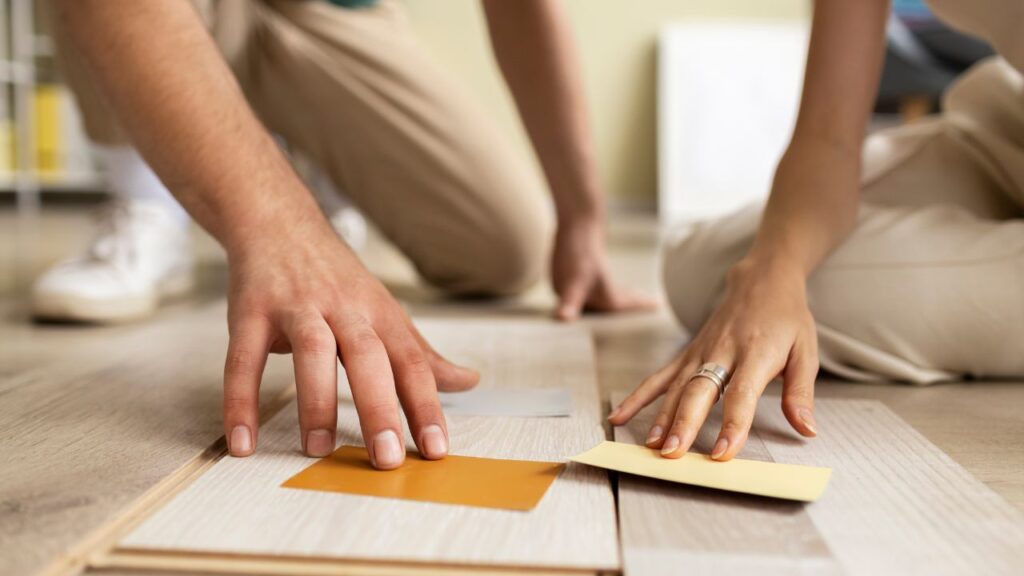
One individual discovered this firsthand when they neglected precisely determining their project’s size requirements and costs before beginning work. After realizing they were significantly over budget due to underestimated fees and undergoing numerous setbacks within their workflow process, they vowed not to make such a costly mistake again.
If you thought filling out your taxes was fun, just wait till you start entering data into the flooring estimator.
To input the necessary data into a flooring estimator, you must first have accurate measurements of your space. This allows the estimator to calculate the amount of flooring materials needed, as well as any additional costs such as underlayment or labor fees.
It’s important to note that using a flooring estimator is intended to be a rough estimate and should not be considered as an exact figure for planning purposes. Additionally, other factors may impact final cost such as disposal fees or tax rates. For more accurate results, consult with a professional installer who can provide detailed quotes based on personalized information about your project requirements and preferences.
Get ready to flex those math muscles, because it’s time to crunch some numbers and calculate that flooring estimate.
When it comes to determining the cost of a flooring project, calculating an estimate is essential. Understanding the various factors that impact the overall price is imperative and can help ensure that you don’t encounter any unpleasant surprises along the way.
To calculate the estimate for your flooring project accurately, follow these three steps:
It’s important to keep in mind that there are numerous additional considerations depending on your specific flooring project requirements. Consulting with a professional estimator or contractor can be incredibly helpful when trying to account for every detail.
While DIY flooring projects might seem like a modern trend, homeowners have been taking matters into their own hands for decades. It wasn’t until 1884 when Frederick Walton introduced linoleum as an easy-to-install option for homeowners looking to upgrade their floors without the expense of hiring professional installers.
Measure twice, cut once – unless you’re using a flooring estimator, then just trust the numbers and save yourself the stress.

To ensure accurate flooring estimation with the right budget and materials, this section provides four essential tips. Measure accurately for a precise estimate, add extra materials to accommodate for potential errors, account for labor costs to determine the final cost, and seek professional help if required. These sub-sections will help you in achieving a realistic flooring estimation.
Accurately Estimating Flooring Needs
To ensure an accurate estimate for your flooring, you must measure precisely by taking into account all necessary variables. The process is essential to save money and minimize waste while ensuring that you have enough material to complete the job.
Follow these six steps to make sure you are measuring accurately:
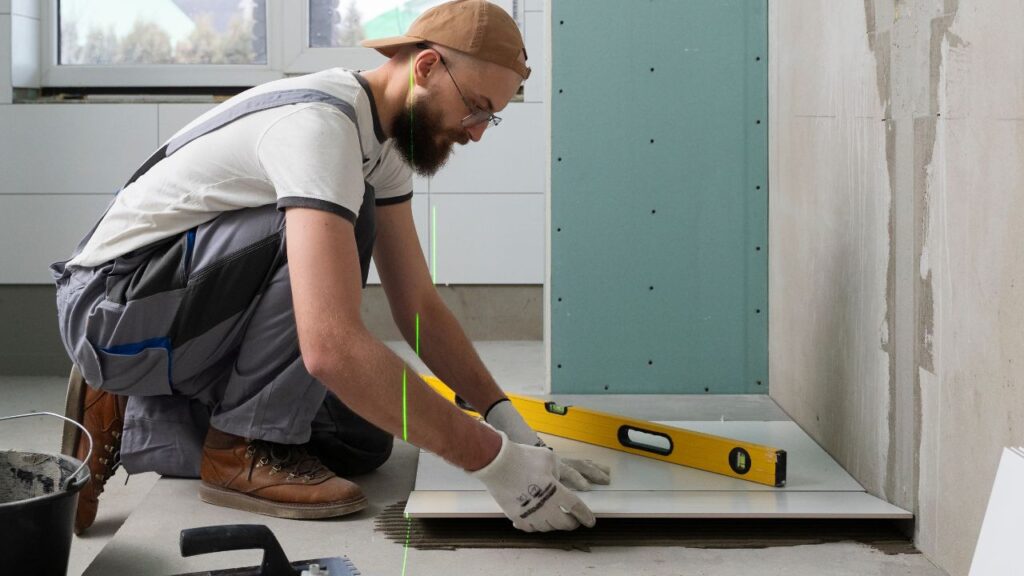
6. Multiply square footage measurements by an extra 10% for likely difficulties during installation, including cutting errors and defects within the planks themselves.
It would help if you also considered factors often overlooked when measuring flooring needs. These factors include directionality, color variation, patterns, moldings, curvatures, doorways, and angles not meeting at 90 degrees height shifts between rooms and recesses.
A fascinating history reveals how much our practices have evolved throughout modern history. Before standardization became prevalent within construction fields upon their sophisticated industrialization era, flooring estimation has been unpredictable due to unreliable measurement methods like the pilferage system tools used at that time.
If you want extra materials for your flooring project, just tell your contractor you’ve got trust issues.
To ensure accurate flooring estimation, it is important to consider adding supplementary materials. This could prevent unforeseen issues arising from miscalculations. Here are some helpful tips for estimating the amount of additional material required.
Materials | Description |
Underlayment | A layer added beneath the top surface of flooring to provide extra support and cushioning. |
Transition strips | The materials used to bridge gaps between different types of flooring, such as carpet-to-wood or tile-to-carpet. |
Trim/moulding pieces | Pieces custom-fit to create a finished look around edges, doorways or where different types of floors meet. |
Note: The quantity needed will depend on the area’s size and design. | |
Moreover, when calculating the amount of primary material required for your flooring project (such as tiles or planks), it is also important to factor in any waste you may encounter during the process. This includes the extra material cut off during installation due to irregular-shaped areas. By planning ahead and considering these factors, you can maintain accuracy in your estimates and save time and money down the road. An interesting study by Flooring Inc found that using extra underlayment can improve sound insulation by up to 30%. Don’t forget to factor in the cost of hiring someone to do the hard work- unless you’re willing to DIY and risk having your floor looking like a toddler’s art project.
When estimating flooring costs, it is crucial to consider labor expenses. Professionals are required to install most flooring types correctly. The estimated time and wage for the hired professionals must be taken into account in determining the final cost of a flooring project.
Failure to calculate labor costs can lead to pricing discrepancies and unforeseen expenses that could affect budget planning. When calculating an estimate, it is important to know how much work needs doing, how many people will be required, what their skill level is, and how long the project will take overall.
To avoid extras from unexpected costs of labor, budget experts urge developers to check product warranties for repair or replacement prior to starting projects. Moreover, while comparing service providers’ quotes, clients must not only focus on price but also ensure they follow ethical practices in working conditions and quality of materials used.
A client once shared his experience with a flooring contractor who seemed cheaper than others. He agreed over the phone without checking their referrals or visiting their office site. He was surprised that cheap came expensive when he noticed errors that needed redoing after finishing the job by technicians who were inexperienced due to lower pay rates offered by the contractor.
Unless you want your floors to look like a modern art installation, seeking professional help for flooring estimation is highly recommended.
When estimating flooring, it’s essential to seek expertise from qualified professionals. These specialists have the knowledge and skills to accurately determine the requirements of your project based on your needs and budget.
Working with a professional can assist you in avoiding costly miscalculations or mistakes. They can provide you with an accurate estimate of the amount of flooring material and labor required for your project. This allows you to plan accordingly and avoid any hindrances during installation.
Remember, every project is unique, and thus requires unique solutions. A professional can understand these uniquenesses and suggest the right kind of flooring material that fits your budget, style, and preferences.
According to Angie’s List, hiring a Certified Flooring Installer guarantees that you’re working with a skilled tradesperson who has received training from well-respected industry organizations.
Flooring estimation may not be rocket science, but having a Flooring Estimator tool handy definitely makes it less ‘arithmetic-al’.
Flooring estimator is an essential tool for both homeowners and contractors, providing accurate estimates for the cost of a flooring project. It streamlines the process of estimating material and labor costs, as well as delivery time. By using this fantastic tool, homeowners can have an idea of how much they need to spend on their flooring projects, while contractors can create detailed project expenses that enable them to provide quotes quickly.
Using a flooring estimator allows homeowners and contractors to get an accurate estimate of the total cost of the project without any hidden or unexpected costs. It ensures transparency in pricing and enables better budgeting decisions. The tool is user-friendly, providing reliable calculations that save time and money while still maintaining high-quality output.
Moreover, flooring estimators can take multiple variables into account, such as room size or material type, making it easier for homeowners and contractors to navigate complex floor plans. With just a few clicks on the website or app’s interface, one can get quick results that match up with their needs.
It’s vital to keep in mind that not all flooring estimators are equally created; therefore it’s worthwhile selecting a reputable supplier with proper reviews from previous customers.
A flooring estimator is a tool used to calculate the rough estimate of the cost of materials, installation, and labor for a flooring project.
A flooring estimator can provide a rough estimate of the cost of your flooring project. However, the actual cost may vary depending on several factors such as the type of flooring, the size of the room, and installation costs.
Although it is not necessary to use a flooring estimator, it can be a helpful tool to get an idea of the cost of the project before contacting a professional.
A flooring estimator typically requires you to input the room’s dimensions, the type of flooring, and the installation method. Then the estimator will provide a rough estimate of the cost of materials, installation, and labor.
Most flooring estimators can provide estimates for all types of flooring, including hardwood, laminate, tile, vinyl, and carpet.
You can contact a flooring professional by searching for local flooring companies online, asking for recommendations from friends and family, or contacting your local home improvement store.
Here I am going to share some steps to get your flooring construction cost estimate report.
You can send us your plan on info@estimatorflorida.com
Before starting your project, we send you a quote for your service. That quote will have detailed information about your project. Here you will get information about the size, difficulty, complexity and bid date when determining pricing.
We do flooring construction cost estimating and prepare a detailed report for your project. At last you finalize the report and finish the project.
561-530-2845
info@estimatorflorida.com
Address
5245 Wiles Rd Apt 3-102 St. Pete Beach, FL 33073 United States
561-530-2845
info@estimatorflorida.com
Address
5245 Wiles Rd Apt 3-102 St. Pete Beach, FL 33073 United States
All copyright © Reserved | Designed By V Marketing Media | Disclaimer
IMPORTANT: Make sure the email and cell phone number you enter are correct. We will email and text you a link to get started.
By clicking “I Agree” above you give Estimate Florida Consultin express written consent to deliver or cause to be delivered calls and messages to you by email, telephone, pre-recorded message, autodialer, and text. Message and data rates may apply. You are able to opt-out at any time. You can text STOP to cancel future text messages.